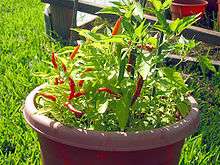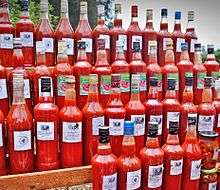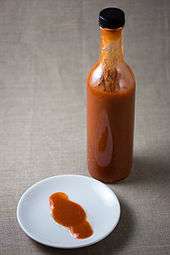Peri-peri
Peri-peri (/ˌpɪri ˈpɪri/ PIRR-ee-PIRR-ee, often hyphenated or as one word, and with variant spellings piri-piri or pili pili) is a cultivar of Capsicum frutescens that was originally produced by Portuguese explorers in Mozambique[1][2] from the malagueta pepper and then spread to other Portuguese territories.
| Peri-Peri | |
|---|---|
 Pili pili peppers (ripe red and unripe green) | |
| Genus | Capsicum |
| Species | Capsicum frutescens |
| Cultivar | Pili pili |
| Heat | |
| Scoville scale | 50,000–175,000 SHU |
Etymology
Pilipili in Swahili means "pepper". Other romanizations include pili pili in the Democratic Republic of the Congo and peri peri in Malawi, deriving from various pronunciations of the word in different parts of Bantu-speaking Africa. Peri peri is also the spelling used as a loanword in some African Portuguese-language countries, especially in the Mozambican community. The peri-peri spelling is common in English, for example in reference to African-style chili sauce, but in Portuguese it's nearly always spelled piri-piri.[3]
The Oxford Dictionary of English records peri-peri as a foreign word meaning "a very hot sauce made with red chilli peppers", and gives its ultimate origin as the word for "pepper" (presumably in the native-African sense) in the Ronga language of southern Mozambique, where Portuguese explorers developed the homonymous cultivar from malagueta pepper.[4]
Plant characteristics
Plants are usually very bushy and grow in height to 45–120 cm (18–47 in) with leaves 4–7 cm (1.6–2.8 in) long and 1.3–1.5 cm (0.51–0.59 in) wide. The fruits are generally tapered to a blunt point and measure up to 2–3 cm (0.8–1 in) long. Immature pod color is green, mature color is bright red or purple. Some Bird's eye chili varieties measure up to 175,000 Scoville heat units.[5]
Cultivation
Like all chili peppers, piri piri is descended from plants from the Americas, but it has grown in the wild in Africa for centuries and is now cultivated commercially in Zambia, Uganda, Malawi, Zimbabwe,[6] and Rwanda. It grows mainly in Malawi, Zambia, South Africa, Ghana, Nigeria, Zimbabwe, Mozambique and Portugal. It is cultivated for both commercial food processing and the pharmaceutical industry. Cultivation of piri piri is labor-intensive.[6]
Peri-peri sauce

Sauce made from peri-peri chilis (used as a seasoning or marinade) is Portuguese-African in origin and is "especially prevalent in Angola, Namibia, Mozambique and South Africa".[7]
Recipes vary from region to region, and sometimes within the same region depending on intended use (ex., cooking vs. seasoning at the table) but the key ingredients are chili and garlic, with an oily or acidic base.[8][9] [10]
Other common ingredients are salt, spirits (namely whisky), citrus peel, onion, pepper, bay leaves, paprika, pimiento, basil, oregano, and tarragon.[11]
References
- "It turns out you were learning to love peri-peri long before we ever had Nando's". The Independent. 18 July 2017. Retrieved 7 May 2020.
- "History of Piri Piri Chicken". Food Fun Travel Blog. 13 January 2020. Retrieved 7 May 2020.
- "Peri-Peri | Definition of Peri-Peri by Lexico". Lexico Dictionaries | English. Retrieved 25 September 2019.
- Stevenson, Angus, ed. (2010). "piri-piri, noun". Oxford Dictionary of English. Oxford University Press.
- "The Scoville scale". www.alimentarium.org. Retrieved 20 February 2019.
- "Pepper Profile: African Birdseye". Fiery Foods and Barbecue SuperSite. Retrieved 27 December 2011.
- Rowley Leigh, "A Fiery Challenge for Delicate Palates", The Financial Times, London, 25 September 2004, p. 6.
- Raghavan, Susheela (23 October 2006). "Handbook of Spices, Seasonings, and Flavorings". doi:10.1201/b13597. Cite journal requires
|journal=(help) - https://www.vaqueiro.pt/recipes/molho-de-piripiri-200661
- https://www.cooked.com/uk/Rebecca-Seal/Hardie-Grant-Books/Lisbon/Sauces--preserves/Piri-piri-sauce-recipe
- Bender, David A., ed. (2009). "piri-piri". A Dictionary of Food and Nutrition. Oxford University Press. doi:10.1093/acref/9780199234875.001.0001. ISBN 9780199234875. Retrieved 24 February 2013.
External links


